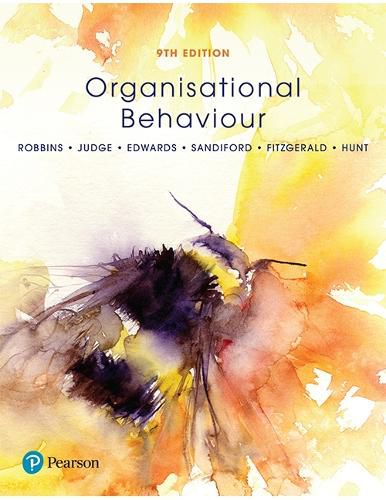Organisational Behaviour
Stephen Robbins,Timothy Judge,Marissa Edwards,Peter Sandiford,Martin Fitzgerald

Organisational Behaviour
Stephen Robbins,Timothy Judge,Marissa Edwards,Peter Sandiford,Martin Fitzgerald
Help students better understand their behavioural and interpersonal skills and prepare them for the realities of the modern workplace.
Long considered the standard for all organisational behaviour textbooks, Organisational Behaviour provides the research you want, in the language your students understand. This text continues its tradition of making current, relevant research come alive for readers.
There’s a reason why Robbins’s textbooks have educated millions of students and have been translated into twenty languages - and it’s because of a commitment that provides the kind of engaging, cutting-edge material that helps students understand and connect with organisational behaviour.
In the dynamic, fast-paced and diverse 21st century workplace, managers and their employees are facing more challenges than ever before. In turn, educators must help to prepare their students for the reality of work and this text will support them to achieve this goal. This 9th edition is one of the most contemporary revisions of Organisational Behaviour undertaken. While the book’s trademark features have been retained - clear writing style, solid theoretical underpinnings, cutting-edge content and engaging pedagogy - each chapter has been thoroughly updated to reflect the most recent research within the field of organisational behaviour and the major practical issues facing employees and managers in the contemporary workplace.
Samples Download the detailed table of contents
Preview a sample chapter from Organisational Behaviour
Features
Each chapter begins with a list of Learning Objectives that outline what you should be able to do after studying the chapter. These objectives are designed to focus your attention on the major issues detailed in the chapter.
The new Employability Skills Matrix shows how the features in the chapter will support you in developing the skills employers are looking for.
An opening Vignette provides an example about an individual or an organisation relevant to the content in that chapter. The featured individuals or organisations come from a broad spectrum and each example is selected specifically to help you link OB concepts to OB practice.
The Myth or Science? feature presents a commonly accepted ‘fact’ about human behaviour, followed by confirming or disproving research evidence. These sections help you to see how the field of OB, built on a large body of research evidence, can provide valuable insights into human behaviour at work.
The new Career Objectives feature provides advice, in question-and-answer format, to help you think through how OB concepts can help you address issues you may face in the workforce.
The Key Terms are highlighted in bold print when they first appear and are defined in the adjoining margin. The terms are also grouped together at the end of the book in the glossary.
The Ethical Choice features are based on real business scenarios and situations that have posed an ethical dilemma.
The Summary and Implications for Managers sections offer a concise summary of the key themes.
The Point/Counterpoint feature presents opposing positions on hot topics in OB to help you learn to think critically.
Questions for Review align with the chapter learning objectives to help you thoroughly revise the content.
Application and Employability summarises the relevance of the chapter to your employability, the skills you will have learned from chapter features and the skills you will learn by completing the end-of-chaptermaterial.
Experiential Exercises provide you with an opportunity to actively engage in your learning of the chapter content either in a group or individually.
Case Studies give you the opportunity to apply the knowledge gained in the chapter to situations in organisations, both real and hypothetical.
New to this edition
An Employability Skills Matrix in every chapter provides students with a visual guideto features that support the development of skills employers are looking for in today'sbusiness graduates, helping students to see the relevance of the course to their careergoals. A Career Objectives feature in every chapter provides advice in a question-and-answerformat to help students think through issues they may face in the workforce.
An Application and Employability section at the end of every chapter summarises therelevance of each chapter for students’ employability, the skills learned from chapterfeatures and the skills to be learned in the end-of-chapter material. A new/updated opening vignette in each chapter brings current business trends and eventsto the forefront. New/updated content in each chapter reflects the most current developments in OBresearch, including:
expatriate readjustment deviance and counterproductive work behaviours
customer satisfaction emotional labour ethics of emotion regulation
mindfulness
invisible illnesses
unemployment/job search
behavioural ethics abusive supervision
executive board composition espoused and enacted climates sleep deprivation recovery experiences job demands pro-social and socially aversive leadership types of organisational culture forces for organisational change the nature of organisational change planned versus emergent change sources and types of resistance to change the stress-performance relationship a contemporary model of workplace stress.
This item is not currently in-stock. It can be ordered online and is expected to ship in 3-5 days
Our stock data is updated periodically, and availability may change throughout the day for in-demand items. Please call the relevant shop for the most current stock information. Prices are subject to change without notice.
Sign in or become a Readings Member to add this title to a wishlist.

